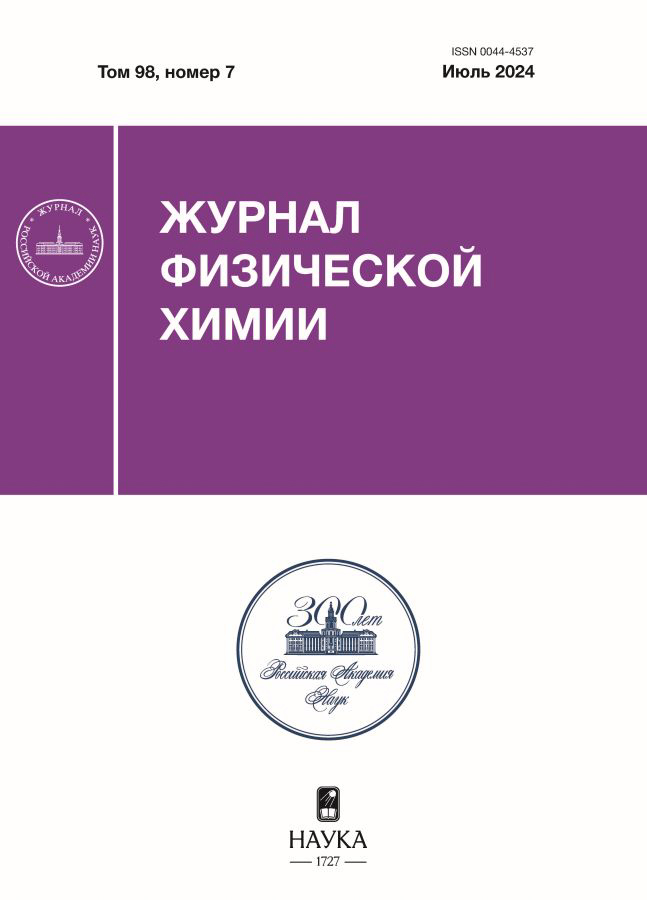Экспериментальные и молекулярно-динамические исследования процессов сорбции н-бутанола и бутилацетата на поверхности SiO2
- Autores: Холмуродов Х.Т.1,2,3, Симоненко И.О.1, Гладышев П.П.1, Яблоков М.Ю.1,4
-
Afiliações:
- Государственный университет “Дубна”
- ОИЯИ
- Московский государственный университет им. М. В. Ломоносова
- Институт синтетических полимерных материалов им. Н. С. Ениколопова РАН
- Edição: Volume 98, Nº 7 (2024)
- Páginas: 124-133
- Seção: PHYSICAL CHEMISTRY OF DISPERSED SYSTEMS AND SURFACE PHENOMENA
- ##submission.dateSubmitted##: 27.02.2025
- ##submission.datePublished##: 15.07.2024
- URL: https://rjmseer.com/0044-4537/article/view/668972
- DOI: https://doi.org/10.31857/S0044453724070152
- EDN: https://elibrary.ru/PURMMO
- ID: 668972
Citar
Texto integral
Resumo
Настоящая работа посвящена экспериментальному и молекулярно-динамическому изучению сорбционных процессов н-бутанола и бутилацетата на поверхности SiO2. Экспериментальные измерения процессов адсорбции/десорбции н-бутанола и бутилацетата на поверхности SiO2 включают в себя данные термокинетической спектрометрии, а моделирование методом компьютерной молекулярной динамики (МД) включало в себя температурные, энергетические и структурные характеристики процессов адсорбции н-бутанола и бутилацетата на поверхности SiO2. По данным МД-моделирования тройной системы “поверхность (SiO2) – несущий газ (Ar) – молекула-мишень (н-бутанол и бутилацетат)” построены и проанализированы профили функции радиального распределения (ФРР) при трех значениях температуры системы Т = 300, 500 и 700 К. Из анализа графиков ФРР н-бутанола и бутилацетата видно, что замещение –OH-группы на ацетатную влияет на конфигурацию атомов C1(Q= –3) и O1(Q= –2) углеродного “скелета” (C1(Q= –3)–C2(Q= –2)–C3(Q= –2)–C4(Q= –1)–O1(Q= –2)) на поверхности SiO2. Более того, сравнительный анализ результатов позволяет предположить, что добавление ацетатной группы увеличивает энергию активации адсорбции молекулы бутилацетата к поверхности SiO2 при повышенных температурах (700 K) по сравнению с н-бутанолом. Экспериментальные данные о процессах десорбции н-бутанола и бутилацетата с поверхности SiO2 в тройной системе н-бутанол/SiO2/аргон дают значение энергии активации десорбции 78.83 кДж/моль, а значение предэкспоненциального множителя – 4.41×107 с–1. Для системы “бутилацетат/SiO2/аргон” значение энергии активации десорбции составило 87.58 кДж/моль, значение предэкспоненциального множителя – 1.81×1010 с–1. Значения энергий активации десорбции подтверждают гипотезу об увеличении энергии активации адсорбции при замещении –OH-группы в н-бутаноле на ацетатную группу в бутилацетате.
Palavras-chave
Texto integral
Sobre autores
Х. Холмуродов
Государственный университет “Дубна”; ОИЯИ; Московский государственный университет им. М. В. Ломоносова
Autor responsável pela correspondência
Email: mirzo@jinr.ru
ОИЯИ, Лаборатория нейтронной физики им. И. М. Франка; Московский государственный университет им. М. В. Ломоносова, Физический факультет
Rússia, 141980, Дубна, Московская обл.; 141980, Дубна, Московская обл.; 119991, МоскваИ. Симоненко
Государственный университет “Дубна”
Email: mirzo@jinr.ru
Rússia, 141980, Дубна, Московская обл.
П. Гладышев
Государственный университет “Дубна”
Email: mirzo@jinr.ru
Rússia, 141980, Дубна, Московская обл.
М. Яблоков
Государственный университет “Дубна”; Институт синтетических полимерных материалов им. Н. С. Ениколопова РАН
Email: mirzo@jinr.ru
Rússia, 141980, Дубна, Московская обл.; 117393, Москва
Bibliografia
- Капустин Д.В., Простякова А.И., Зыбин Д.И., Зубов В.П. // Российские нанотехнологии. 2021. Т. 16. № 1. С. 23.
- Оленинa А.Ю., Лисичкин Г.В. // Журн. общ. химии. 2019. Т. 89. № 7. С. 1101.
- Пахнутова Е.А., Фаустова Ж.В., Слижов Ю.Г. // Журн. физ. химии. 2018. Т. 92. № 1. С. 135.
- Kudryavtsev P.G. // Nanotechnologies in construction. 2020. V. 12(5). P. 256.
- Rykowska I., Wasiak W. // Z. Chemia Analityczna. 2003. V. 48. № 3. P. 495.
- Гладышев Д.П., Гладышев П.П., Гущин А.П. / Сб. трудов кафедры химии, геохимии и космохимии. Часть 1. Дубна: Международный университет природы, общества и человека “Дубна”. 2009.
- Гладышев П.П., Зуев Б.К., Моржухина С.В. / Теоретические предпосылки термокинетической спектроскопии. Тр. кафедры химии, новых технологий и материалов: выпуск 1 / под общ. ред. П.П. Гладышева. 2014. № 1. С. 78.
- Холмуродов Х.Т., Пузынин И.В., Дарден Т. // Физика элементарных частиц и атомного ядра. 2003. Т. 34. № 2. С. 474.
- Bushuev Y.G., Sastre G. // Microporous and Mesoporous Materials. 2010. V. 129(1–2). P. 42.
- Cygan R.T., Liang J.-J., Kalinichev A.G. // J. Phys. Chem. B. 2004. V. 108(4). P. 1255.
- Shropshire J., Keat P.P., Vanghan P.A. // Z. Kristallogr. 1959. V. 112. P. 409.
- Brooks B.R., Bruccoleri R.E., Olafson B.D., et al. // J. of Computational Chemistry. 1983. https://doi.org/10.1002/jcc.540040211.
- Case D.A., Cheatham T.E., Darden T., et al. // Ibid. 2005. V. 26(16). P. 1668.
- Smith W., Forester T.R. // J. Mol. Graph. 1996. V. 14. P. 136.
- Kholmirzo Kholmurodov (Ed.), “Models in Bioscience and Materials Research: Molecular Dynamics and Related Techniques”, Nova Science Publishers Ltd., 2013. 219 p., ISBN: 978-1-62808-052-0.
- Kholmirzo Kholmurodov (Ed.), “Computational Materials and Biological Sceinces”, Nova Science Publishers Ltd., 2015. 208 p., ISBN: 978-1-63482-541-2.
- Kholmirzo T. Kholmurodov (Ed). “Computer Design for New Drugs and Materials. Moleсular Dynamics of Nanoscale Phenomena”, (Leading Scientist, Frank Laboratory of Neutron Physics, Joint Institute of Nuclear Research, Dubna, Moscow Region, Russia), ISBN: 978-1-53612-082-0, Nova Science Publishers, New York (2017), 231 p.
- Humphrey W., Dalke A. and Schulten K. // J. Molec. Graphics. 1996. V. 14. P. 33.
- Snow N.H. // Trends Analytical Chemistry. 2001. V. 21. № 9. P. 608.
- Rykowska I., Wasiak W. // Analytica Chimica Acta. 2002. V. 451. № 2. P. 271.
- Ristova M. // J. of Molecular Structure. 2009. P. 93.
- Лисичкин Г.В. Химия привитых поверхностных соединений. М.: Физматлит, 2003. 592 с.
- van Beest B.W.H., Kramer G.J., van Santen R.A. // Phys. Rev. Lett. 1990. V. 64. P. 1955.
- Hill J.-R., Sauer J.J. // Phys. Chem. 1995. V. 99. P. 9536.
- Corma A., Puche M., Rey F., et al. // Angew. Chem. Int. Ed. 2003. V. 42, P. 1156.
- Модифицированные кремнеземы в сорбции, катализе, хроматографии. / Под ред. Г.В. Лисичкина. М.: Химия, 1986. 248 с.
Arquivos suplementares
























